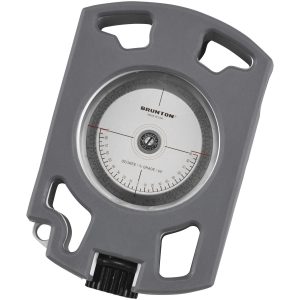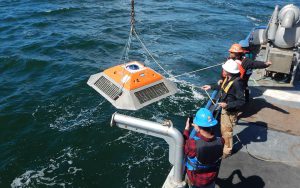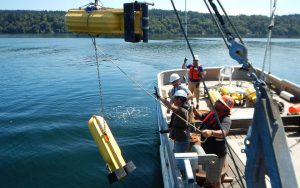When one thinks of the motion of the ocean one immediately thinks of waves. We will discuss waves in another part of this series, but here we are going to focus on the water movement beneath the waves.
Unconsciously – subconsciously – we noticed this movement when we are lowering nets or instruments into the sea from the ship. Peering into the Deep Blue you notice that they do not descend straight down. And, at times, the water clarity is so good you might notice the descending instrument moving to your right, and all of a sudden it is moving to the left. These currents can impact where you instrument REALLY is in the water column. You may let out 100 feet of steel cable thinking your water bottle array is at that depth, but the current is so strong that it may actually be 100 feet behind you and only 75 feet deep! One way oceanographers deal with this problem is by using a clinometer. This is hand-held instrument that acts as sort of a protractor and can measure the angle in which the cable is descending. Knowing the angle, you can do some simple math to determine how much cable to let out to reach a depth of 100 feet. The point here is that the OCEAN IS IN MOTION.

How do oceanographers measure the speed and direction of these currents?
How do you do this at depth?
At the surface is common to deploy a rather larger instrument that can connect with orbiting satellites. The instrument is dropped into the sea and released. It is tracked by satellites and the data collected on a computer. Following these you can see where the current is going, how fast it is moving, and whether its position in the ocean remains the same. Knowing their position these expensive instruments can be retrieved later, re-worked, and deployed again. Oceanographers from numerous countries have such instruments drifting all over the oceans.

Photo: NOAA

Photo: NOAA.
Early oceanographers did a similar thing but did not have the luxury of satellites They would deploy drift bottles with notes to contact them if ever found. There is an oceanographer today who tracks spilt cargo at sea. Much of the items we purchase come from China. These items are loaded onto cargo containers that are stacked high on container ships heading for Seattle or Los Angles. Here they are unloaded, placed on trains or trucks, and brought to you. In heavy seas some of these containers are washed overboard. The captains MUST call these in (it is a hazard at sea) and they are tracked. Oceanographers track them as well. In some cases they are tracking to see where they are going. In others they are tracking to see if their predictions on where landfall will be are right – learning more about surface currents all the time. One oceanographer tracks split cargo from containers. He has tracked rubber ducks and hockey sticks as the drift in the currents of the open Pacific to the coast of the United States. Simple and pretty cool.
At depth you are out of the range of satellites. In many cases these instruments have weights that can be added so that it will sink to a certain water density layer, and then drift at that layer. Some of these are numbered with contact information if found. Others can be logged by GPS satellites as the descend, and then log back in when they return the surface. These are bit harder to track than the surface currents, but the information is still valuable. It was discovered after the Deep Water Horizon oil spill that we did not fully understand how the mid water currents work. Based on the available data, predictions as to where oil would move across the Gulf were given and communities prepared. Many of these predictions to happen, and the oil went a different direction. This let oceanographers know that there is much more to learn about deep sea currents in our oceans.
In Part 6 we will look at life in the Deep Blue.
Sea stories…
On a research cruise there can be down time. There is a small library filled with books and board games, and many take advantage of that. But others, like those of us at home, spend their down time watching TV. In 1994 watching TV at sea was probably not as good as it is today. There was a TV in the galley, but you had to be nearshore for live TV reception. When out of range, there were numerous videos to watch, but live TV could only be viewed during certain parts of the cruise.
On our cruise the NBA playoffs were going on and some members of the crew were interested in updates. On one point we were going to be close enough for live reception. As we got close, those interested went to the galley for the live feed and to see how the playoffs were going. I remember all of us sitting around the tables staring at the television with its “snowy” screen and no sound – waiting…
Then… the picture began to come. The visual came before the audio. But the visual was weird. As the “snowy” screen changed we saw a white bronco driving very slowly down an interstate with several police cars following at the same speed. This went on for several minutes – just following this bronco through what appeared to be Los Angles. A couple of people piped in “what the heck is this? – change the channel” – someone did… but the slow moving white bronco was on every channel. There was no audio, so we were not sure what was going on. “Where are the playoffs?”
Then… a caption came on at the bottom of the screen. “O.J. is in the car”… okay… great… O.J. Simpson is in the car – and the car is moving slow – and the police are following – big deal – WHERE ARE THE PLAYOFFS?
It was not until we got home that we discover why the police were following O.J. Simpson.
 1
1
